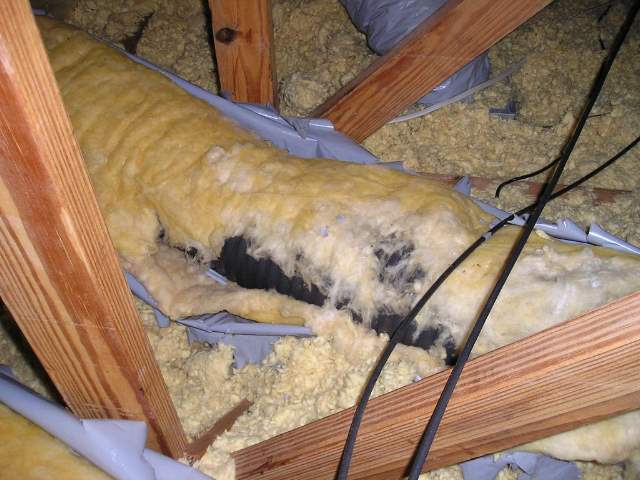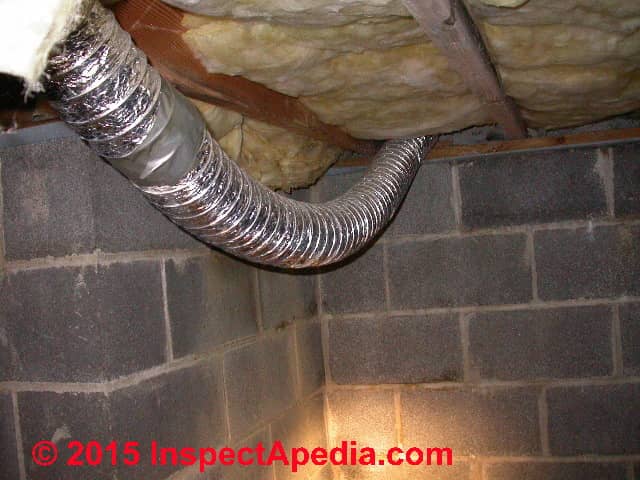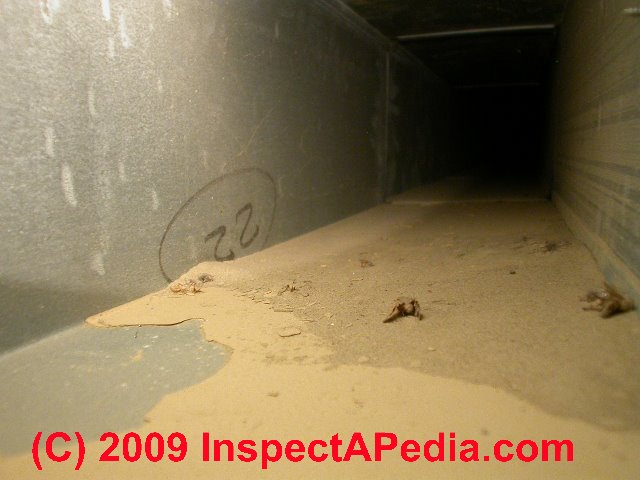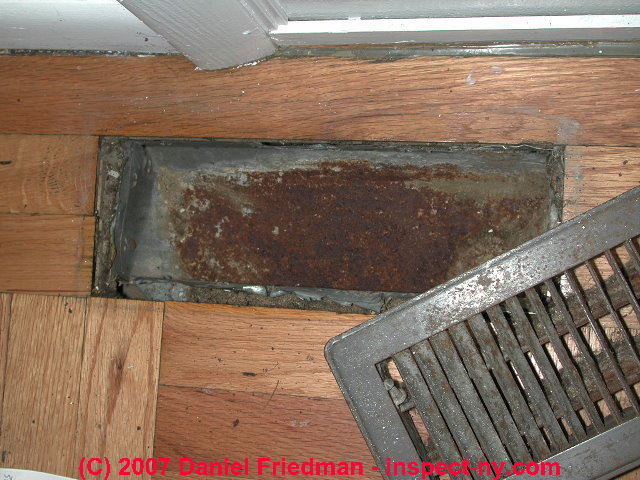 Wet or Corroded Heating or Cooling Ducts
Wet or Corroded Heating or Cooling Ducts
Causes, Health Concerns, Repairs for wet air ducts
- POST a QUESTION or COMMENT about the cause, detection, concerns and cures for wet, flooded, iced or water contaminated ductwork
Air duct leaks, condensation, flooding or wetting = contamination:
This article describes causes, health concerns, & repairs to correct wet or corroded heating & cooling ducts.
Rusty metal ducts or corroded HVAC ducts are an indicator of improper and possibly unhealthy conditions in the building as they are almost always associated with unwanted moisture in the duct system.
Unwanted moisture in cooling ducts in particular, is an invitation to mold, bacterial, or other pathogens in the duct system and thus in the building air. We point out and include photographs of locations where you can spot unwanted HVAC or cooling system moisture and rust, cite some related health concerns, and discuss ways to avoid duct corrosion or rust. We also offer advice on what to do about rusty ductwork.
InspectAPedia tolerates no conflicts of interest. We have no relationship with advertisers, products, or services discussed at this website.
- Daniel Friedman, Publisher/Editor/Author - See WHO ARE WE?
Causes & Cures for Wet, Iced, or Corroded Air Conditioning Duct Work
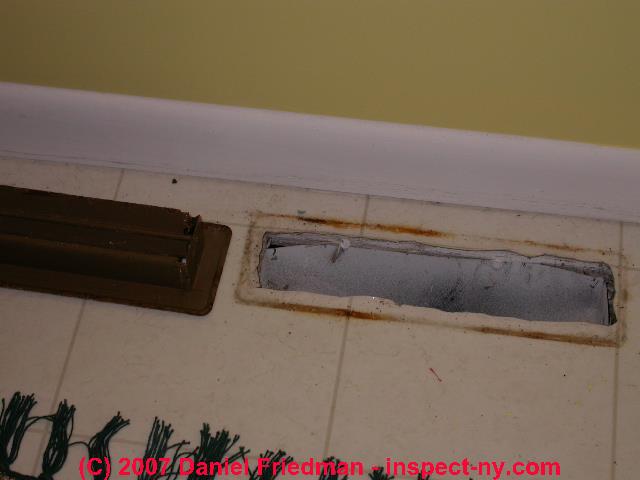
Article Contents
- DUCTWORK MOISTURE SOURCES
- DUCTWORK MOISTURE HAZARDS
- DUCTWORK MOISTURE RISK ASSESSMENT
- WET DUCTWORK REPAIRS
- SPRAYS for MOLDY DUCTWORK? Really?
The photo at page top shows a very rusty air conditioning ductwork register, and a careful look into that system of metal duct work, found additional heavy rust in the duct system along with lots of debris.
The photographs shown here are of a less obviously rusty duct system and the rust stains on the vinyl floor suggest that the water in this duct system came from the floor level.
...
Causes of & Cures For Water or Moisture In HVAC Ducts & Air Handlers
Excessive indoor humidity and its related mold, dust mite, or bacterial hazards may be traced to either a cause or an effect of high moisture inside of an air conditioning system or even heating system duct work or air handler. Here are some common examples of sources of condensation or actual water leaks in HVAC duct systems:
- Missing HVAC duct insulation:
Voids in the insulation or un-insulated supply ducts on an air conditioning ductwork system are likely to cause considerable condensation on the duct exterior wherever the ducts pass through un-conditioned space such as an attic floor where the ducts are exposed to warm moist air.
Some brands of HVAC flex duct have been particularly prone to loss of both the exterior plastic duct covering and ultimately the duct insulation itself.
See GOODMAN GRAY FLEXDUCT for examples of this problem (photo at left).
External condensation on supply ducts is sufficient to show up as a ceiling leak or stain.
Internal condensation may also occur in the duct system where insulation is missing. The accumulation of condensate on the duct interior also risks growth of bacterial, mold or other contaminant hazards. - Convection air currents:
When an HVAC system is off, depending on building temperatures, air may circulate up through ceiling ducts or other ducts by natural convection, carrying moisture that condenses in cooler duct sections (such as in a cold attic in winter) where the condensate in the ductwork may actually form frost or ice that later melts and shows up as a ceiling leak stain.
See WATER & ICE IN DUCT WORK - An over-sized central air conditioner:
Even an over-sized room air conditioner may cool the building area so quickly that the A/C system does not run long enough to adequately dehumidify the building air. A result can include accumulation of condensate in the ductwork interior, especially if the ductwork insulation is incomplete. Details are
at DEHUMIDIFICATION PROBLEMS. - High indoor moisture moving through the building:
A wet basement or crawl space often sends moisture up through the entire building, overwhelming central air conditioning or local dehumidifier's ability to dehumidify the building air to an acceptable level. Ceiling-mounted air ducts may circulate moist indoor air into the duct system by convection even if the blower or air handler is not running. In winter moisture may condense, even freeze and accumulate in such duct systems.
See WATER & ICE IN DUCT WORK
and also
see HUMIDITY CONTROL & TARGETS INDOORS - Leaky HVAC ducts or duct connections:
Leaks in return ducts, because they are under negative pressure, can bring warm moist unconditioned air into the duct system adding to both contamination and moisture condensation problems there.
See LEAKY DUCT CONNECTIONS
and
see RETURN DUCT AIR LEAKS or
see SUPPLY DUCT AIR LEAKS - Leaks or actual flood-waters entering the HVAC duct work:
From a roof leak, plumbing leak, or from a humidifier that is improperly adjusted or improperly located can induce excessive moisture into building air as well as inviting mold contamination of the HVAC system. An extreme example of this problem occurs when a building has been actually flooded.
See FLOOD DAMAGED DUCT WORK
and
see FLOOD DAMAGE HEATING EQUIP. - In-slab HVAC ducts:
Are often subjected to leaks into the duct system or moisture and water collection from ground-water, from plumbing leaks, or from condensation;
see TRANSITE PIPE AIR DUCT ASBESTOS RISKS an example
or
see SLAB DUCTWORK - Condensate blow-off from the cooling coil:
In an air handler will often wet the supply plenum and nearby ductwork in some very humid climates.
Unless there is also a condensate drainage problem in the air conditioner we don't usually see extensive problem mold growth from this blow-off effect, but as the following reader comment (originally posted
at HUMIDITY CONTROL & TARGETS INDOORS) explains, in high-velocity air conditioning systems condensate blow-off can be so extreme as to create a serious indoor moisture problem.
Examples of condensate spill-over inside of an air handler blower compartment, a condition creating a risk of mold growth inside the HVAC system are
at BLOWER LEAKS, RUST & MOLD
See MOLDY Growth in Air Conditioning Blower Fans for an example of mold growth on the air handler blower that was probably encouraged by condensate. - Sagging poorly-supported ductwork:
Encourages the collection of condensate in low portions of the ductwork. We show two sagging flex-duct examples just below.
Excessive indoor humidity traced to wet air ducts caused by high velocity air conditioning system coil condensation blow-off
Reader Comment: Mike / DFW
For years I've been trying to figure out the excessive humidity problem in my home too. I finally found it after working with foundation people, plumbers, a/c techs -- nobody could figure it out, but I finally did. When the cooling kicks on, the moisture level skyrockets. It has affected the inside of my home tremendously. We thought it was the a/c drain.
They re-routed it, made sure it was draining well and clear. It is. Leak near or under the foundation. We checked everything-that wasn't it.
What's happening is the fan is actually sucking the moisture out of the evaporator coils before the condensation off the coils can drain away. The design of this Lennox horizontal system in the attic is such that the small space right above and right below the squirrel type fan, creates a venturi effect, increasing the velocity of the air being sucked into the fan.
The velocity of the air is so strong that the coils (about 12 in. away) have the moisture sucked right off of them and into the fan, which, of course is then blown into the ducting. I'm not sure if this is an engineering design problem, if the a/c co. wired the fan to a speed that's too high, or if perhaps a part is missing that is supposed to prevent this.
Regardless, the inside of the unit is now so covered with mildew and mold and the electrical connections on the heating elements as well as all the electrical connections on the inside of the unit, are so corroded and rusted, it's a wonder that love thing works at all. (This also probably explains why sometimes the heat works and sometimes it doesn't.
The a/c repair guys have never been able to figure out why. They always seem to think it's the thermostat It's not. It's new and has recently been completely re-wired when I moved it from an outside wall to an inside wall.)
Anyway, that's where MY moisture problem is coming from. Good luck! - Mike / DFW 12/13/2012
Reply:
Mike, gold star to you for good detective work. Like other areas in the Southern U.S., Dallas/Fort Worth experiences seasonal periods of high humidity that can result in an extraction rate of water from building air faster than the design of the air handler and condensate drain system can handle it.
More about dehumidification problems traced to central air conditioning systems can be read
at DEHUMIDIFICATION PROBLEMS.
Do you think that the root problem, then, is an improper duct or plenum size or design or a mismatch between blower fan capacity and the HVAC duct system?
...
Are Rusty, Previously Wet, Iced, or Dirty Air Conditioning Ducts a Health Concern?
Not necessarily:
To avoid inappropriate anxiety on the part of any readers we state up front that it is normal for some dust and debris to accumulate on the inside of heating or air conditioning ducts, and this material is not necessarily a hazard to building occupants.
But when ducts have also been wet, or when ducts are constructed of materials like fiberglass insulation that have been damaged or can't be cleaned, some potential health or respiratory issues may be present, as we discuss further here.
Our flooded air duct photo (above left) shows ductwork with a layer of mud - this home was flooded to a level that included ceiling-mounted basement air ducts. The ducts needed to be cleaned and sanitized.
Soil particles themselves may not be a serious health hazard but area flooding often brings pathogens (such as bacteria or viruses found in sewage) into buildings and can form a serious health hazard. Details are
Rust flakes
from rusty heating or air conditioning ducts themselves are unlikely to be much of a health hazard - these particles are pretty big, not easily airborne, and probably won't be found at high levels in indoor air except in unusual circumstances. But rust in ducts is a problem indicator, showing quite clearly that the duct system has been wet.
Dust & normal air duct debris:
The chief components of house dust, which will certainly collect within a duct system include fabric fibers and skin cells, often also including starch fragments and other organic debris.
Watch out: The combination of organic debris within a duct system and water (indicated by rusty ducts or duct registers) indicates a possible risk of mold or bacterial hazards within the air conditioning or heating system. Since blowing air through the system can pick up and distribute these hazards to occupants of the building, wet or previously-wet duct work is a potential health hazard to building occupants.
...
Wet HVAC Ductwork Actual Risk Assessment
The actual health hazard level from wet or previously wet air conditioning or heating ducts in a building depends on these factors:

- The total area of duct or other surfaces that have been wet,
including both duct system interior and the interior of the air handler or fan/blower unit and evaporator coil surface - The level of organic debris
within the duct system. Our photo (left) illustrates a small wet area in a section of flexible air duct - a problem that should be corrected. But if this is the only wet area it does not itself appear to be a health hazard. Make sure that flexible ductwork is properly supported to avoid collecting condensate in low spots. - Presence of visible mold contamination
in the duct system or within the air handler itself. Small amounts of mold, often a species or two of Cladosporium form on blowers and in small areas of the air handler.
While even some species of Cladosporium, the most common mold family, can be a health hazard, a greater risk is likely to be present if the system is contaminated with small, easily-airborne molds such as those in the Aspergillus and Penicillium families.
These are less commonly found as are ductwork mold contaminants that originate not from growing mold colonies in the duct system or air handler but from other building mold reservoirs.
See MOLD in AIR HANDLERS & DUCT WORK
Since odors, including moldy smells, are easily transported from one building to another through its HVAC system, sorting out moldy smells or other odors and tracking them to their source can be tricky.
See ODORS in AIR HANDLERS & DUCT WORK - The materials used to insulate the duct interior:
fiberglass and similar materials form a "sticky" surface that tends to hold debris and also to act as a sponge holding moisture, possibly increasing the risk of mold or bacterial hazards, and not easily cleaned. - The frequency of wet conditions:
recurrent wetting obviously increases the risk of pathogens in the duct work, though we've seen significant contamination as a result of a single building flooding event which wet the ducts - The health vulnerability of individual occupants
in the building: elderly, immune-impaired, asthmatics, infants, people with allergies, people with COPD or other respiratory illness, are more likely to be bothered sooner by duct contaminants that are produced by wet conditions in the air conditioning or heating system.
...
What To Do About Rusty HVAC Ducts, Wet or Previously Wet Fiberglass Ducts or Flex-Duct
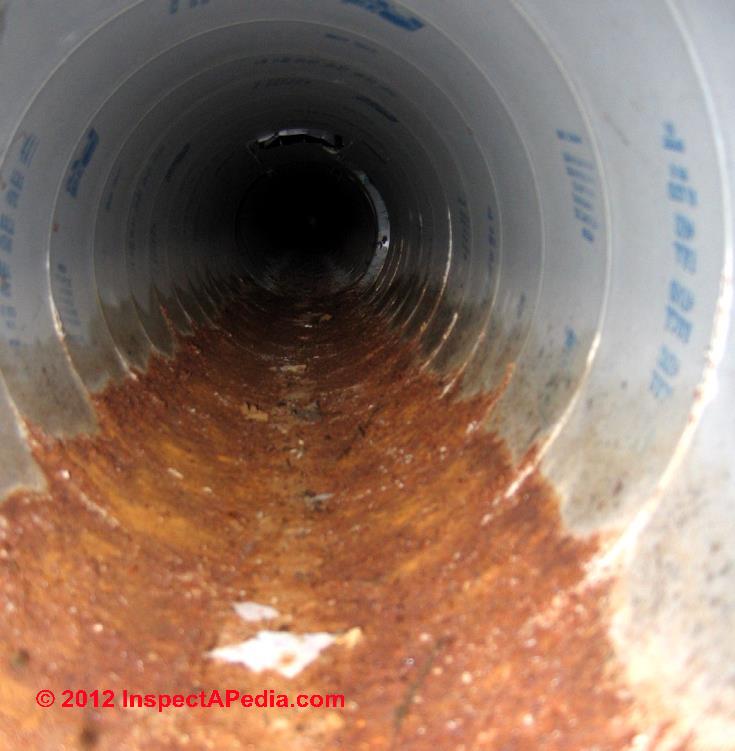
- Clean the ductwork:
Metal ducts that have been wet but are not severely damaged can and should be professionally cleaned. Be sure that the interior of the air handler is also inspected and cleaned. - Replace damaged ductwork:
Where you observe metal duct system components which are quite corroded, badly corroded materials should be replaced. Depending on the location of the ductwork and its accessibility, this might not involve significant expense if only limited sections of readily-accessible duct work are involved. - Replace fiberglass-lined ducts that have been wet:
Fiberglass-lined ducts or flex-ducts which have been wet should be inspected thoroughly, and sections which were wet and/or are particularly soiled should be replaced. While it may be possible to remove-and re-line HVAC ducts that use an interior fiberglass board liner, if more than a small amount of such work is needed, replacement of the ducts may be less costly.
- Inspect for significant mold reservoirs in the ductwork:
Leaks into ducts routed through inaccessible building areas or cavities, and leaks into duct work which has insulation, particularly fiberglass insulation, in its interior, (typically fiberglass board), may harbor a mold colony, leading to both significant cleanup costs and potential health concerns.
...
Use of Sprays, Sealants, Sanitizers in HVAC Duct Systems
Buying a house with very corroded in-floor rusty ductwork: can we just spray-seal the duct interiors?
I am considering buying a 20 year old house which has underground ducting serving both refrigerated air and heat.
I had a duct inspection which revealed severely corroded and rusted ducts with some holes through the ducting.
I have heard of a product by the Duct Seal Technologies in which the inside of the ducts are sprayed with a coating of kevlar fibers and some bonding agent. Do you know anything about this process?
Thanks, Doug Spence - Spence 6/19/2011
Reply: in-slab HVAC ducts are asking for trouble from flooding, vermin, water, mold, etc.
Spence:
About buried or in-floor HVAC ducts: as we suggest in the article above, even if you could reliably reline your in-ground or under-slab air ducts (and how without a detailed inspection would we know that the re-coating or relining was complete, and that it remained intact?) there remains a concern with radon gas or water leaks into the duct system.
And we are doubtful about the reliability of this approach: spray-on coatings don't bond well to dirty, rusted, corroded surfaces and may fail to seal large penetrations or holes; And even a well-sealed spray-coated in-slab HVAC duct, if subjected to future flooding from ground water or plumbing leaks, or invasion by rodents or other pests, is simply going to have new contamination in its interior.
A better, but usually much more costly and disruptive solution is to eliminate the in-slab ductwork by rerouting it through the building.
If you go ahead with the process I'd recommend first an inspection for evidence of a history of duct flooding, and an annual inspection of the duct condition until you are confident of its dryness and cleanliness.
Also take a look at TRANSITE PIPE AIR DUCT ASBESTOS RISKS for more examples of problems with heating or air conditioning ducts found in slabs.
...
...
Continue reading at WATER & ICE IN DUCT WORK or select a topic from the closely-related articles below, or see the complete ARTICLE INDEX.
Or see WET CORRODED DUCT WORK FAQs, diagnostic questions & answers posted originally at this page.
Or see these
Recommended Articles
- ALUMINUM BUILDING MATERIAL ODORS
- BLOWER LEAKS, RUST & MOLD
- FROST BUILD-UP on AIR CONDITIONER COILS
- FLOOD DAMAGE REPAIR PRIORITIES
- FLOOD DAMAGE CLEANUP & REPAIR GUIDE - home
- HEATING EQUIPMENT, FLOOD DAMAGE REPAIR
- TRANSITE PIPE AIR DUCT ASBESTOS RISKS where we describe flooding of HVAC ductwork in slabs
- PVC HVAC DUCTS
- SLAB DUCTWORK
- WATER & ICE IN DUCT WORK
- WET CORRODED DUCT WORK
Suggested citation for this web page
WET CORRODED DUCT WORK at InspectApedia.com - online encyclopedia of building & environmental inspection, testing, diagnosis, repair, & problem prevention advice.
Or see this
INDEX to RELATED ARTICLES: ARTICLE INDEX to HVAC DUCT SYSTEMS
Or use the SEARCH BOX found below to Ask a Question or Search InspectApedia
Ask a Question or Search InspectApedia
Try the search box just below, or if you prefer, post a question or comment in the Comments box below and we will respond promptly.
Search the InspectApedia website
Note: appearance of your Comment below may be delayed: if your comment contains an image, photograph, web link, or text that looks to the software as if it might be a web link, your posting will appear after it has been approved by a moderator. Apologies for the delay.
Only one image can be added per comment but you can post as many comments, and therefore images, as you like.
You will not receive a notification when a response to your question has been posted.
Please bookmark this page to make it easy for you to check back for our response.
IF above you see "Comment Form is loading comments..." then COMMENT BOX - countable.ca / bawkbox.com IS NOT WORKING.
In any case you are welcome to send an email directly to us at InspectApedia.com at editor@inspectApedia.com
We'll reply to you directly. Please help us help you by noting, in your email, the URL of the InspectApedia page where you wanted to comment.
Citations & References
In addition to any citations in the article above, a full list is available on request.
- Air Diffusion Council, 1901 N. Roselle Road, Suite 800, Schaumburg, Illinois 60195, Tel: (847) 706-6750, Fax: (847) 706-6751 - Email: info@flexibleduct.org - www.flexibleduct.org/ -
- Owens Corning Duct Solutions - www.owenscorning.com/ductsolutions/ - provides current HVAC ductwork and duct insulating product descriptions and a dealer locator. Owens Corning Insulating Systems, LLC, One Owens Corning Parkway, Toledo, OH 43659 1-800-GET-PINK™
- "Flexible Duct Media Fiberglas™ Insulation, Product Data Sheet", Owens Corning - see owenscorning.com/quietzone/pdfs/QZFlexible_DataSheet.pdf
"Owens Corning Flexible Duct Media Insulation is a lightweight, flexible, resilient thermal and acoustical insulation made of inorganic glass fibers bonded with a thermosetting resin." - In addition to citations & references found in this article, see the research citations given at the end of the related articles found at our suggested
CONTINUE READING or RECOMMENDED ARTICLES.
- Carson, Dunlop & Associates Ltd., 120 Carlton Street Suite 407, Toronto ON M5A 4K2. Tel: (416) 964-9415 1-800-268-7070 Email: info@carsondunlop.com. Alan Carson is a past president of ASHI, the American Society of Home Inspectors.
Thanks to Alan Carson and Bob Dunlop, for permission for InspectAPedia to use text excerpts from The HOME REFERENCE BOOK - the Encyclopedia of Homes and to use illustrations from The ILLUSTRATED HOME .
Carson Dunlop Associates provides extensive home inspection education and report writing material. In gratitude we provide links to tsome Carson Dunlop Associates products and services.



